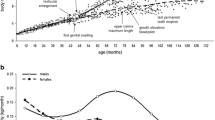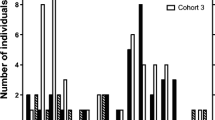Summary
Empirical associations among co-adapted traits such as body size and patterns of reproduction, development, and behavior are unknown for most animal species, despite numerous theories suggesting otherwise. One way to study these complex relationships is first to consider closely related species and then to generalize findings to other groups. In the present study, relationships among body size, reproductive patterns, development, and sociality were examined in 17 members of the family Canidae (canids). Large canids are more social than smaller species, and offspring of large species achieve independence and tend to breed first at a later age. Large females give birth to absolutely larger young, but relative to their own body weight they allocate fewer resources to bringing a large pup to term. Overall, sexual dimorphism in size is small to moderate, and this is associated with monogamous mating habits and paternal care of young.
Similar content being viewed by others
References
Altmann SA, Altmann J (1979) Demographic constraints on behavior and social organization. In: Primate ecology and human origins. IS Bernstei, EO Smith (eds), New York, Garland, pp 47–63
Armitage K (1981) Sociality as a life-history tactic of ground squirrels. Oecologia (Berl) 48:36–49
Barash DP (1974) The evolution of marmot societies: a general theory. Science 185:415–420
Bekoff M (1977) Mammalian dispersal and the ontogeny of individual behavioral phenotypes. Am Nat 111:715–732
Bekoff M (1981) Mammalian sibling interactions: genes, facilitative environments and the coefficient of familiarity. In: Parental care in mammals. DJ Gubernick, PH Klopfer (eds), New York: Plenum, pp 307–346
Bekoff M, Jamieson R (1975) Physical development in coyotes (Canis latrans) with a comparison to other canids. J Mammal 56:685–692
Bekoff M, Wells MC (1980) Social ecology of coyotes. Sci Am 242:130–148
Bowen D (1978) Prey size and coyote social organization. PhD Diss Univ British Columbia, Vancouver, B C, Canada
Camenzind F (1978) Behavioral ecology of coyotes on the National Elk Refuge, Jackson. In: Coyotes: biology, behavior, and management. M Bekoff (ed) New York: Academic Press, pp 267–294
Clutton-Brock TH, Harvey PH (1977) Primate ecology and social organization. J Zool Lond 183:1–39
Clutton-Brock TH, Harvey PH (1978) Mammals, resources and competitive strategies, Nature 273:191–195
Cole LC (1954) The population consequences of life history phenomena. Q Rev Biol 29:103–137
Ewer RF (1973) The carnivores. New York: Cornell Univ Press
van Gelder RG (1978) A review of canid classification. Am Mus Novitates No 2646:1–10
Kihlström JE (1972) Period of gestation and body weight in some placental mammals. Comp Biochem Physiol 43A:673–680
King CM, Moors PJ (1979) The life-history tactics of mustelids, and their significance for predator control and conservation in New Zealand. New Zealand J Zool 6:619–622
Kleiman DG (1977) Momogamy in mammals. Q Rev Biol 52:39–69
Kleiman DG, Eisenberg JF (1973) Comparisons of canid and felid social systems from an evolutionary perspective. Anim Behav 21:637–659
Kleiman DG, Eisenberg JF, Maliniak E (1979) Reproductive parameters and productivity of caviomorph rodents. In: Vertebrate ecology in the northern neotropics. JF Eisenberg (ed) Washington, DC: Smithsonian, pp 173–183
Leitch, I, Hytten FE, Billewicz WZ (1959) The maternal and neonatal weights of some mammals. Proc Zool Soc Lond 133:11–28
Macdonald DW (1979) The flexible social system of the golden jackal, Canis aureus. Behav Ecol Sociobiol 5:17–38
Macdonald DW (1980) Social factors affecting reproduction amongst red foxes. In: E Zimen (ed) The red fox. The Hague: Dr W Junk BV, pp 123–175
Mace GM (1979) The evolutionary ecology of small mammals. PhD Diss. Univ of Sussex, Sussex, England
Packard J (1980) Deferred reproduction in wolves (Canis lupus). PhD Diss Univ of Minnesota, Minneapolis
Ralls K (1977) Sexual dimorphism in mammals: avian models and unanswered questions. Am Nat 111:917–938
Rautenbach I, Nel JAJ (1978) Coexistence in Transvaal carnivora. Bull Carnegie Mus Nat Hist 6: 138–145
Robbins CT, Robbins BL (1979) Fetal and neonatal growth patterns and maternal reproductive effort in ungulates and subungulates. Am Nat 114:101–116
Sokal R, Rohlf F (1969) Biometry. San Francisco: Freeman
Stearns SC (1976) Life history tacties: A review of the ideas. Q Rev Biol 51:3–47
Stearns SC (1977) The evolution of life history traits: a critique of the theory and a review of the data. Ann Rev Ecol Syst 8:145–171
Stearns SC (1980) A new view of life-history evolution. Oikos 35:266–281
Tuomi J (1980) Mammalian reproductive strategies: a generalized relation of litter size to body size. Oecologia (Berl) 45:39–44
Western D (1979) Size, life history and ecology in mammals. Afr J Ecol 17:185–204
Wiley RH (1974) Evolution of social organization and life-history patterns among grouse. Q Rev Biol 49:201–227
Wilson EO (1975) Sociobiology: The new synthesis. Cambridge, Mass.: Harvard Univ Press
Zimen E (1976) On the regulation of pack size in wolves. Z Tierpsychol 40:300–341
Author information
Authors and Affiliations
Rights and permissions
About this article
Cite this article
Bekoff, M., Diamond, J. & Mitton, J.B. Life-history patterns and sociality in canids: Body size, reproduction, and behavior. Oecologia 50, 386–390 (1981). https://doi.org/10.1007/BF00344981
Received:
Issue Date:
DOI: https://doi.org/10.1007/BF00344981




